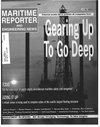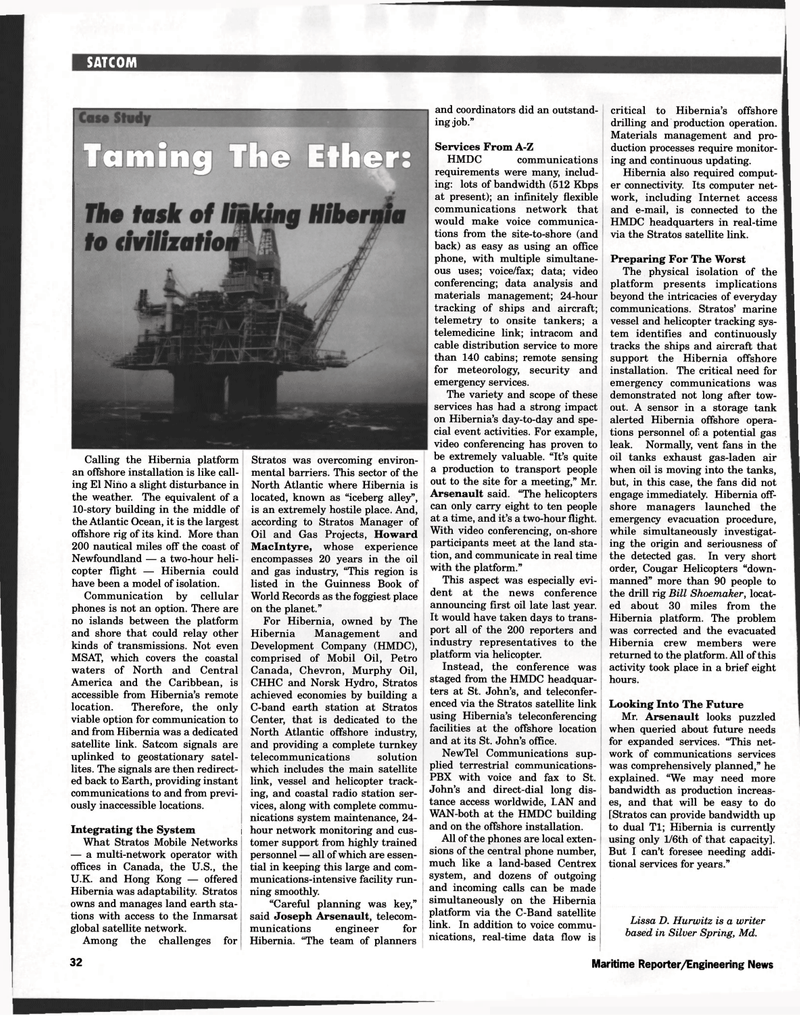
Page 40: of Maritime Reporter Magazine (April 1998)
Read this page in Pdf, Flash or Html5 edition of April 1998 Maritime Reporter Magazine
SATCOM and coordinators did an outstand- ing job."
Calling the Hibernia platform an offshore installation is like call- ing El Nino a slight disturbance in the weather. The equivalent of a 10-story building in the middle of the Atlantic Ocean, it is the largest offshore rig of its kind. More than 200 nautical miles off the coast of
Newfoundland — a two-hour heli- copter flight — Hibernia could have been a model of isolation.
Communication by cellular phones is not an option. There are no islands between the platform and shore that could relay other kinds of transmissions. Not even
MSAT, which covers the coastal waters of North and Central
America and the Caribbean, is accessible from Hibernia's remote location. Therefore, the only viable option for communication to and from Hibernia was a dedicated satellite link. Satcom signals are uplinked to geostationary satel- lites. The signals are then redirect- ed back to Earth, providing instant communications to and from previ- ously inaccessible locations.
Integrating the System j
What Stratos Mobile Networks — a multi-network operator with offices in Canada, the U.S., the
U.K. and Hong Kong — offered
Hibernia was adaptability. Stratos owns and manages land earth sta- tions with access to the Inmarsat global satellite network.
Among the challenges for
Stratos was overcoming environ- mental barriers. This sector of the
North Atlantic where Hibernia is located, known as "iceberg alley", is an extremely hostile place. And, according to Stratos Manager of
Oil and Gas Projects, Howard
Maclntyre, whose experience encompasses 20 years in the oil and gas industry, "This region is listed in the Guinness Book of
World Records as the foggiest place on the planet."
For Hibernia, owned by The
Hibernia Management and
Development Company (HMDC), comprised of Mobil Oil, Petro
Canada, Chevron, Murphy Oil,
CHHC and Norsk Hydro, Stratos achieved economies by building a
C-band earth station at Stratos
Center, that is dedicated to the
North Atlantic offshore industry, and providing a complete turnkey telecommunications solution which includes the main satellite link, vessel and helicopter track- ing, and coastal radio station ser- vices, along with complete commu- nications system maintenance, 24- hour network monitoring and cus- tomer support from highly trained personnel — all of which are essen- tial in keeping this large and com- munications-intensive facility run- ning smoothly. "Careful planning was key," said Joseph Arsenault, telecom- munications engineer for
Hibernia. "The team of planners
Services From A-Z
HMDC communications requirements were many, includ- ing: lots of bandwidth (512 Kbps at present); an infinitely flexible communications network that would make voice communica- tions from the site-to-shore (and back) as easy as using an office phone, with multiple simultane- ous uses; voice/fax; data; video conferencing; data analysis and materials management; 24-hour tracking of ships and aircraft; telemetry to onsite tankers; a telemedicine link; intracom and cable distribution service to more than 140 cabins; remote sensing for meteorology, security and emergency services.
The variety and scope of these services has had a strong impact on Hibernia's day-to-day and spe- cial event activities. For example, video conferencing has proven to be extremely valuable. "It's quite a production to transport people out to the site for a meeting," Mr.
Arsenault said. "The helicopters can only carry eight to ten people at a time, and it's a two-hour flight.
With video conferencing, on-shore participants meet at the land sta- tion, and communicate in real time with the platform."
This aspect was especially evi- dent at the news conference announcing first oil late last year.
It would have taken days to trans- port all of the 200 reporters and industry representatives to the platform via helicopter.
Instead, the conference was staged from the HMDC headquar- ters at St. John's, and teleconfer- enced via the Stratos satellite link using Hibernia's teleconferencing facilities at the offshore location and at its St. John's office.
NewTel Communications sup- plied terrestrial communications-
PBX with voice and fax to St.
John's and direct-dial long dis- tance access worldwide, LAN and
WAN-both at the HMDC building and on the offshore installation.
All of the phones are local exten- sions of the central phone number, much like a land-based Centrex system, and dozens of outgoing and incoming calls can be made simultaneously on the Hibernia platform via the C-Band satellite link. In addition to voice commu- nications, real-time data flow is critical to Hibernia's offshore drilling and production operation.
Materials management and pro- duction processes require monitor- ing and continuous updating.
Hibernia also required comput- er connectivity. Its computer net- work, including Internet access and e-mail, is connected to the
HMDC headquarters in real-time via the Stratos satellite link.
Preparing For The Worst
The physical isolation of the platform presents implications beyond the intricacies of everyday communications. Stratos' marine vessel and helicopter tracking sys- tem identifies and continuously tracks the ships and aircraft that support the Hibernia offshore installation. The critical need for emergency communications was demonstrated not long after tow- out. A sensor in a storage tank alerted Hibernia offshore opera- tions personnel of a potential gas leak. Normally, vent fans in the oil tanks exhaust gas-laden air when oil is moving into the tanks, but, in this case, the fans did not engage immediately. Hibernia off- shore managers launched the emergency evacuation procedure, while simultaneously investigat- ing the origin and seriousness of the detected gas. In very short order, Cougar Helicopters "down- manned" more than 90 people to the drill rig Bill Shoemaker, locat- ed about 30 miles from the
Hibernia platform. The problem was corrected and the evacuated
Hibernia crew members were returned to the platform. All of this activity took place in a brief eight hours.
Looking Into The Future
Mr. Arsenault looks puzzled when queried about future needs for expanded services. "This net- work of communications services was comprehensively planned," he explained. "We may need more bandwidth as production increas- es, and that will be easy to do [Stratos can provide bandwidth up to dual Tl; Hibernia is currently using only l/6th of that capacity].
But I can't foresee needing addi- tional services for years."
Lissa D. Hurwitz is a writer based in Silver Spring, Md. 32 Maritime Reporter/Engineering News

 39
39

 41
41
